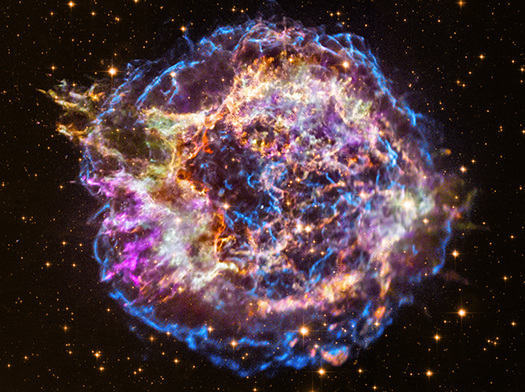Watch As a Supernova Morphs and Its Speedy Shock Waves Reverse
Including unusually fast-moving shock waves.
A new video from NASA shows how a supernova explosion morphs and changes during a 13-year period, The growing debris field, known as Cassiopeia A or Cas A, likely was generated after a star explosion in 1680. New data from NASA's Chandra X-Ray Observatory shows that even an old explosion can change in subtle ways during a human lifetime.
If you watch the arrows in the video closely, you can see shock waves in blue reverberating through space in data collected between 2000 and 2013. The shock waves are producing X-ray emissions and accelerating particles to high speeds.
The video combines X-ray data from Chandra with observations from the Hubble Space Telescope, which observes in visual and infrared light. Hubble's data was held constant to emphasize the changes Chandra observed over time, according to Chandra personnel.
Related: NASA Unveils Amazing Cosmic Views as Chandra X-Ray Observatory Turns 20
"As the blast wave travels outwards at speeds of about 11 million miles [18 million km] per hour, it encounters surrounding material and slows down, generating a second shock wave," Chandra mission personnel said in a statement. This "reverse shock," the agency continued, "travels backwards, similar to how a traffic jam travels backwards from the scene of an accident on a highway."
While reverse shocks typically travel more slowly than the initial blast wave, scientists have realized that some of those in Cas A do the opposite. Their speeds remain fairly high, between about 5 million and 9 million mph (8 million and 14 million km/h). The phenomenon could be the result of the initial blast wave running into a patch of material and slowing down.

Cas A was the first object that Chandra observed, shortly after its launch to space on July 23, 1999. That first observation yielded new science, NASA noted, because Chandra observed a neutron star — the dense remnant left behind from a star explosion — embedded in the debris.
Get the Space.com Newsletter
Breaking space news, the latest updates on rocket launches, skywatching events and more!
Other observations from Chandra over the decades have shown some of the key elements for life in the explosion and have also generated 3D models of the supernova remnant, NASA said.
- Gallery: Amazing Nebula Photos From Chandra & Hubble
- See the X-ray Neighborhood of the First-Ever Black Hole Photo in This Space Telescope View
- NASA's Chandra Space Telescope Captures the Tempest in a Cosmic 'Teacup'
Follow Elizabeth Howell on Twitter @howellspace. Follow us on Twitter @Spacedotcom and on Facebook.
Join our Space Forums to keep talking space on the latest missions, night sky and more! And if you have a news tip, correction or comment, let us know at: community@space.com.

Elizabeth Howell (she/her), Ph.D., was a staff writer in the spaceflight channel between 2022 and 2024 specializing in Canadian space news. She was contributing writer for Space.com for 10 years from 2012 to 2024. Elizabeth's reporting includes multiple exclusives with the White House, leading world coverage about a lost-and-found space tomato on the International Space Station, witnessing five human spaceflight launches on two continents, flying parabolic, working inside a spacesuit, and participating in a simulated Mars mission. Her latest book, "Why Am I Taller?" (ECW Press, 2022) is co-written with astronaut Dave Williams.









